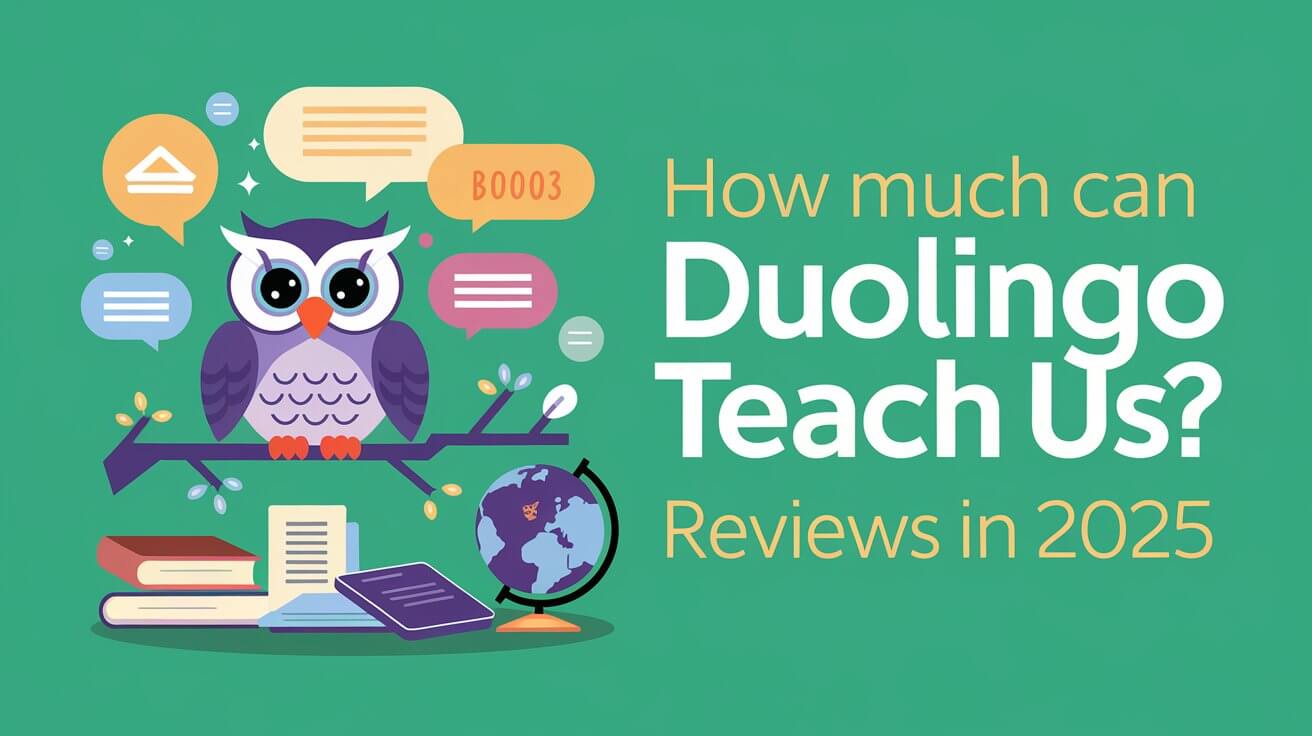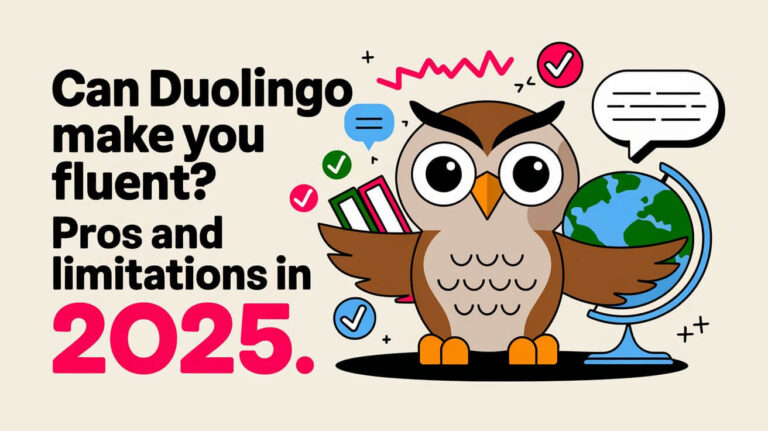Duolingo is a top language learning app known for its fun and interactive lessons. It offers over 45 language courses, from Spanish and French to Navajo and Welsh. This makes it a great place for people to learn new languages.
Duolingo focuses on learning by doing and building a community. This approach is different from other apps. It’s perfect for those wanting to get better at languages through Duolingo.
Duolingo’s creator, Luis von Ahn, thinks AI can be better teachers than humans. The app uses listening exercises, flashcards, and quizzes to teach new words and phrases. This method has made Duolingo very popular, becoming the most downloaded education app worldwide.
Real Language Skills From Duolingo
Duolingo is a well-known app for learning languages. It focuses on real language skills, not just rules. Its interactive lessons make learning fun and engaging.
Using Duolingo can boost your vocabulary and basic conversation skills. Lessons are short, lasting 5-10 minutes. This makes it easy to fit into your busy schedule. The app also has a gamified approach to keep you motivated.
Basic Conversation Skills
Duolingo’s lessons help you get better at listening and speaking. You can practice your pronunciation and intonation through speaking exercises.
Grammar Foundations
Duolingo teaches grammar in a way that’s easy to understand. It helps you apply grammar rules in real situations. This way, you can build more complex sentences over time.
Vocabulary Building
Duolingo’s exercises focus on common words and phrases. Its spaced repetition system helps you remember vocabulary and grammar. This keeps your language skills sharp and improves your proficiency.
Language Proficiency Levels Achievable
Duolingo offers courses in over 40 languages. It helps users learn languages in a comprehensive way. Through interactive lessons and exercises, users can develop their language skills.
The app’s personalized experience is created by experts and native speakers. This helps users progress and improve their language skills.
Studies show Duolingo is effective for language learning. Learners do as well as university students in reading and listening tests. But, it might not be enough for advanced skills or conversational fluency.
To reach higher levels, users should spend 10-15 minutes a day on Duolingo. This helps reinforce and expand their language skills.
Using Duolingo has many benefits. These include:
- Improved reading and writing skills
- Enhanced vocabulary and grammar knowledge
- Personalized lessons and exercises
- Gamified approach to motivate users
Practicing with Duolingo, users can achieve a high level of language proficiency. It’s a great tool for learning languages.
| Language Skill | Duolingo’s Effectiveness |
|---|---|
| Reading | Highly effective |
| Writing | Effective |
| Speaking | Less effective |
Duolingo’s Teaching Methods
Duolingo makes learning languages fun and effective. It uses spaced repetition to help you remember new words and phrases. This method is proven to work well in language learning.
Duolingo also adds gamification to make learning more fun. You earn points, badges, and can see how you rank against others. This keeps you motivated to keep learning.
Some of the key features of Duolingo’s teaching methods include:
- Personalized lessons based on individual user progress
- Interactive and engaging exercises to practice new language skills
- Spaced repetition to help reinforce new information
- Gamification elements to motivate users and make learning more enjoyable
Duolingo offers a fun and effective way to learn new languages. Its use of spaced repetition, gamification, and progress tracking makes learning enjoyable. It also provides a structured learning experience.
| Feature | Description |
|---|---|
| Spaced Repetition | Helps users memorize new words and phrases by reinforcing new information at increasingly longer intervals |
| Gamification | Makes language learning more enjoyable and interactive through the use of points, badges, and leaderboards |
| Progress Tracking | Helps users monitor their progress and stay motivated |
Time Required for Language Mastery
Learning a new language with Duolingo can take different amounts of time. This depends on your starting level, how much time you spend learning, and how often you practice. Duolingo’s method helps users become proficient quickly.
It’s estimated that finishing one section of the Spanish course takes 3-4 weeks with regular practice. The time to finish the whole course can be a few months to over a year. This depends on how fast you learn and how often you practice.
- Getting really good at a language takes longer than just finishing the course. You need to practice more after using Duolingo.
- It’s best to practice every day, even if it’s just for a few minutes. This helps keep what you’ve learned fresh.
- Talking with native speakers can really help you feel more confident and fluent. This shows how important it is to use your new language in real conversations.
Using Duolingo regularly and adding other learning methods, you can become very good at a language quickly. Duolingo is faster than traditional learning methods. This makes it a great choice for those who want to learn a new language fast and well.
| Language Level | Time Required | Practice Consistency |
|---|---|---|
| Basic | 1-3 months | Daily practice, 15-30 minutes |
| Intermediate | 6-12 months | Regular practice, 30-60 minutes |
| Advanced | 1-2 years | Consistent practice, 60-90 minutes |
Common Language Patterns Taught
Duolingo’s courses teach various language patterns like sentence structure and daily expressions. It focuses on learning by doing, not just memorizing rules. This way, learners get to use language in real-life situations, making it more useful.
Sentence Structure
Knowing how to build sentences is key for good communication. Duolingo teaches users to create sentences that are right and make sense. This skill helps learners speak clearly and accurately.
Daily Expressions
Duolingo also teaches common phrases used in daily talks. These phrases make learners sound more natural and fluent. By using these phrases, users can communicate more authentically.
Cultural Context
Duolingo also covers cultural aspects of language. It gives insights into cultural nuances and customs. This helps learners understand language better and use it respectfully.
Some examples of language patterns and cultural context include:
- Using formal and informal language in different social situations
- Understanding idiomatic expressions and colloquialisms
- Recognizing cultural references and allusions
Teaching these, Duolingo helps users grasp the language better. They can then communicate more effectively with native speakers.
Pronunciation and Speaking Practice
Duolingo’s courses aim to boost your speaking skills. They offer interactive exercises to make learning fun. About 50% of users who finished Unit 5 can speak at least at an A2 level.
Some interesting facts about Duolingo’s speaking practice include:
- 66% of Spanish learners scored A2 or higher in speaking proficiency
- 53% of French learners scored A2 or higher in speaking proficiency
- Spanish pronunciation scores approached B1, marking it as the highest subscore for both languages
Duolingo’s speaking exercises help users improve their pronunciation and fluency. This makes learning a language more than just reading and writing. It’s a full experience.
Duolingo’s approach to speaking and pronunciation is key. It helps users become more confident and skilled in their target language. This makes them better communicators.
Success Rate Among Users
Duolingo’s success rate shows how well the app teaches language skills. Many users become very good at speaking and writing in new languages. This success proves Duolingo’s ability to make learning fun and effective.
Interactive lessons, games, and tracking features are key to Duolingo’s success. These tools keep users motivated and engaged. This leads to better results for users, whether they want to talk better, read, or pass a language test.
Beginner Outcomes
Beginners do amazingly well with Duolingo. They quickly learn the basics and start talking with native speakers. Duolingo focuses on practical skills, not just grammar rules. This helps beginners feel confident and ready to learn more.
Advanced User Results
Advanced users also benefit a lot from Duolingo. The app’s advanced lessons improve their skills and understanding. This leads to better communication and helps them reach their goals, whether for work or personal reasons.
Professional Achievement Stories
Many Duolingo users have found professional success thanks to their language skills. They’ve gotten jobs in international companies or started their own businesses. These stories show how important language skills are for career growth. Duolingo helps users get the skills they need to succeed.
| Language | Number of Learners | Success Rate |
|---|---|---|
| English | 100 million | 80% |
| Spanish | 50 million | 75% |
| French | 30 million | 70% |
How Much Can Duolingo Teach Us
Duolingo is a powerful tool for learning languages. It offers a complete approach to getting language skills. With fun exercises and games, Duolingo helps users speak their target language well. It covers basic chats to advanced grammar and vocabulary.
Duolingo gives personalized lessons and exercises. It uses algorithms to track your progress and find areas to improve. This makes learning a language fun and relevant with real-world examples.
Some key skills Duolingo teaches include:
- Basic conversation skills, such as greetings and introductions
- Grammar and sentence structure, including verb conjugation and tense
- Vocabulary building, with a focus on common words and phrases
- Reading and listening comprehension, with interactive exercises and quizzes
Duolingo is great for anyone wanting to learn a new language or get better at one they already know. It offers a full learning experience with fun exercises. This helps users reach their language goals and become proficient.
| Language Skill | Description |
|---|---|
| Basic Conversation Skills | Greetings, introductions, and basic phrases |
| Grammar and Sentence Structure | Verb conjugation, tense, and sentence formation |
| Vocabulary Building | Common words and phrases, including idioms and expressions |
| Reading and Listening Comprehension | Interactive exercises and quizzes to improve reading and listening skills |
App Features Beyond Basic Lessons
Duolingo’s app features make learning languages fun and interactive. It has tools and resources like stories, podcasts, and social learning. These features help users practice their language skills and make learning a full experience.
Some of the key app features include:
- Stories and podcasts to improve reading, writing, and listening skills
- Social learning elements, such as clubs and leaderboards, to encourage interaction and competition
- Achievement systems, including points, rewards, and level progression, to motivate users
Stories and Podcasts
Duolingo’s stories and podcasts help users practice their language skills. They are designed to be engaging and interactive. With topics for all levels, Duolingo meets different learning needs.
Social Learning Elements
Duolingo’s social features, like clubs and leaderboards, let users interact and compete. These features build a sense of community and motivation. They make learning a language more fun and effective.
| App Feature | Description |
|---|---|
| Stories and Podcasts | Improve reading, writing, and listening skills |
| Social Learning Elements | Encourage interaction and competition |
| Achievement Systems | Motivate users with points, rewards, and level progression |
Duolingo offers more than just basic lessons. Its engaging features make learning languages enjoyable and effective. This helps users reach their language learning goals.
Practice Methods and Effectiveness
Learning a new language is easier with the right practice methods. Duolingo, a well-known platform, offers fun and effective ways to learn. It focuses on making learning interactive and engaging.
Duolingo’s methods are designed to help you learn quickly. They include reading, writing, listening, and speaking exercises. This way, you can improve many skills at once.
Some key features of Duolingo’s methods are:
- Interactive lessons and exercises
- Personalized feedback and assessment
- Gamification elements to enhance engagement and motivation
- Opportunities to practice speaking and listening skills through interactive conversations
Duolingo offers a unique and effective way to learn a language. It’s great for beginners and advanced learners alike. Duolingo’s approach and interactive methods make it a top choice for language learners.
Limitations and Challenges
Duolingo has changed the way we learn languages, but it’s not perfect. One big issue is the lack of speaking practice. This is key to mastering a language. Duolingo does offer some speaking exercises, but it can’t match the cultural depth of other methods.
Some of the main issues with Duolingo are:
- Speaking practice constraints: Duolingo lets you practice speaking, but it might not be enough for true fluency.
- Cultural immersion gaps: Duolingo doesn’t offer much cultural context, making it hard to grasp language nuances.
- Advanced level restrictions: Duolingo’s content might be too simple for advanced learners, who find it too easy.
Even with these issues, Duolingo is still a great tool for learning languages. Users can use it as a starting point and add other learning methods. This way, they can get a deeper understanding of the language, overcoming Duolingo’s limitations.
Final Words
Duolingo has become a key tool for language learners. It offers a complete way to learn practical language skills. The app uses games, feedback, and a detailed curriculum to help users learn grammar, vocabulary, and how to talk.
While it might not make you fluent, Duolingo’s methods are great for getting to an intermediate level. Studies show this is true.
Duolingo has many language options for people all over the world. It makes learning languages fun and easy. Features like the Spaced Repetition System and interactive exercises help you remember what you learn.
As Duolingo grows, so will the learning experiences it offers. More languages will be available for you to learn.
If you’re starting out or want to improve your skills, Duolingo is a great choice. It’s a flexible and effective way to learn a language. Using Duolingo can open doors to new opportunities and help you master a language.
Post-Specific FAQs
What language skills can Duolingo teach?
Duolingo teaches basic conversation skills, grammar, and vocabulary. It uses implicit learning to help you understand the language naturally.
What are the language proficiency levels achievable with Duolingo?
Duolingo helps you reach high levels of language proficiency. It covers beginner to advanced levels. You’ll learn to communicate well in your target language.
What teaching methods does Duolingo use?
Duolingo uses spaced repetition, gamification, and progress tracking. These make learning languages fun and effective.
How long does it take to master a language with Duolingo?
Mastering a language with Duolingo varies. It depends on your starting level, how much time you spend learning, and how often you practice. Duolingo’s approach can help you reach high proficiency quickly.
What common language patterns does Duolingo teach?
Duolingo teaches common language patterns. This includes sentence structure, daily expressions, and cultural context. Its focus on implicit learning helps you understand the language naturally.
How effective is Duolingo’s pronunciation and speaking practice?
Duolingo’s exercises improve your speaking and pronunciation. The app’s interactive approach makes practicing fun and engaging.
What is Duolingo’s success rate among users?
Duolingo’s success rate shows it’s effective for teaching language skills. It helps users reach high levels of proficiency, from beginner to advanced.
What app features does Duolingo offer beyond basic lessons?
Duolingo offers stories, podcasts, social learning, and achievement systems. These features make learning languages more engaging and interactive.
How effective are Duolingo’s practice methods?
Duolingo’s practice methods are effective and fun. They focus on interactive learning and feedback. This comprehensive approach helps you communicate effectively in your target language.
What are the limitations and challenges of using Duolingo?
Duolingo is a powerful tool for learning languages. But, it has limitations. It may not offer the same cultural immersion as other methods. It’s also not ideal for advanced learners seeking deeper instruction.







